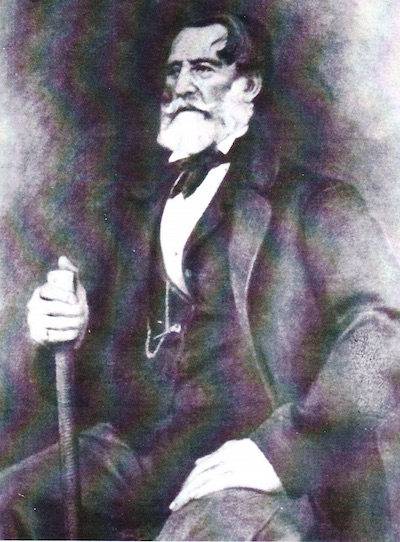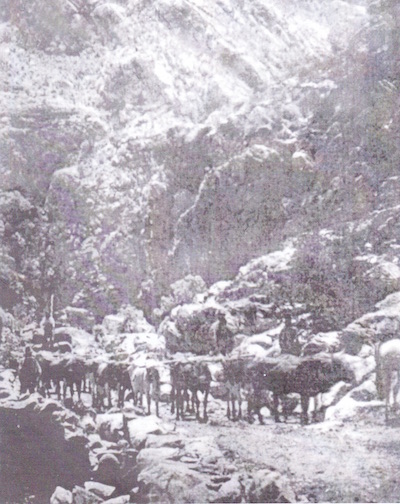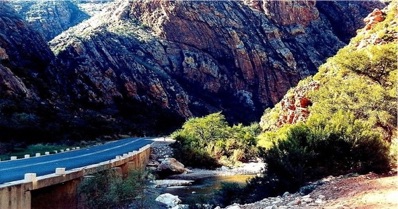Meiringspoort: Heritage & Environment
 Meiringspoort
Meiringspoort
FOLLOW THESE LINKS FOR INFORMATION ON MEIRINGSPOORT'S
GEOLOGY FLORA FAUNA THE DRIFTS THE GREAT WATERFALL
Meiringspoort - An unique ecosystem
Compiled by: W.J. Immelman
 Pierneef: Double Drift Corner
Pierneef: Double Drift Corner
Introduction:
Meiringspoort today is undoubtedly one of the most scenic mountain passes in South Africa. Stretching through a massive cleft in the Swartberg Mountain Range, this natural passage forms a convenient link between the Little and Great Karoo. Not only for the lovers of Fauna and Flora but also the geologist will find the rock formations and rock strata very interesting.
Meiringspoort is also the inspiration for artwork of Thinus de Jongh and Pierneef (Double Drift Corner - see below.) Even our previous anthem got its well known “over everlasting mountains, where the echoing crags resound” from Meiringspoort.
History:
Meiringspoort is named after Petrus Johannes Meiring. He was born in 1799 and was a grandson of Dominee Arnoldus Meiring who arrived in 1743 from Lingen, Germany.
 PJ Meiring
PJ Meiring
In 1848 Petrus made the first recorded transit of the poort. Later he and Gerome Marincowitz from the farm Vrolikheid, near Klaarstroom at the northern end of the poort, opened up a bridle path along the Grootriver, then known as ’De Groote Stroom’.
In 1854 after many petitions from wool farmers of the Great Karoo, farmers from George, Mossel Bay and Oudtshoorn, who wished to trade wood, furniture, potatoes and sweet potatoes, decisions were made to build a road.
In August of that year John Molteno,( destined to become Prime Minister), Andrew Geddes Bain, his son Thomas Bain, and Charles Pritchard, a Beaufort West lawyer, travelled from Beaufort West by horse to examine the route through the mountains.
As a result of the subsequent report it was decided that the so called ‘boer’ road, which would be subject to frequent wash-aways, was the answer. An amount of £5000 was made available. As the Governor of the Cape Colony, Sir George Grey, was in favour of the road through the poort, the Legislative Assembly allocated £ 5000 for the building of the road. In August 1856 work on the road started.
 The old road through MeiringspoortMeiringspoort was officially opened to traffic early on the morning of the 3rd of March 1858. There was a colourful procession and a tearful guest of honour – the champagne bottle only broke after the third attempt! It was, as previously stated, named after Petrus Johannes Meiring from De Rust. The first freight of wool (twaalf lange wolwagens) from the interior was dispatched to Mossel Bay on the same day as the official opening of Meiringspoort.
The old road through MeiringspoortMeiringspoort was officially opened to traffic early on the morning of the 3rd of March 1858. There was a colourful procession and a tearful guest of honour – the champagne bottle only broke after the third attempt! It was, as previously stated, named after Petrus Johannes Meiring from De Rust. The first freight of wool (twaalf lange wolwagens) from the interior was dispatched to Mossel Bay on the same day as the official opening of Meiringspoort.
The Meiringspoort road opened doors for trading from the south and to the north of the poort. Tollhouses that were built, they also served as shops and dwelling houses. The first toll- keeper Rankin functioned here for 15 years. He became famous as the local herbalist and tooth-extractor. It was reported on the 3rd of June 1870 more than one million kilograms of wool was transported through Meiringspoort and sold at Mossel Bay. By then the two villages De Rust and Klaarstoom on either side of the poort were well established.
In 1885 a flash flood washed away most of the road and Thomas Bain was asked for assistance. He was busy with the Swartberg Pass but nevertheless saw to the construction of Meiringspoort and by 1886, he redirected the course to eliminate a number of river crossings.
|
Meiringspoort – Construction Details
The route was surveyed at various stages by a Mr Woodfield, Adam DE SMIDT, Andrew BAIN, and later Thomas Bain. Initial work was done by Thomas J Mellville, Sub-Inspector of Roads in the George District with a labour-force of 93 hired labourers, but replaced by Adam de SMIDT as supervisor under general control of Thomas BAIN. Here Bain invented the rock-splitting technique of creating bonfires over impeding rocks then shattering the heated rocks with buckets of cold water. This traversable cutting gave direct link to the Great Karoo and its produce, the wool clip, to the outside world.
|
 Ox wagon in Meiringspoort 1878 Ox wagon in Meiringspoort 1878 |
 Horse cart crossing one of the streams at Double Drift in Meiringspoort Horse cart crossing one of the streams at Double Drift in Meiringspoort |
|
|
Ox wagon in Meiringspoort 1878 |
Horse cart crossing one of the streams at Double Drift in Meiringspoort |
 Rankin’s Toll Gate at the Southern Entrance to Meiringspoort 1876
Rankin’s Toll Gate at the Southern Entrance to Meiringspoort 1876
Rankin’s Toll Gate at the Southern Entrance to Meiringspoort 1876
 Dr. Russel of Oudtshoorn in his 1902 Wolseley Siddeley crossing one of the drifts at Meiringspoort.
Dr. Russel of Oudtshoorn in his 1902 Wolseley Siddeley crossing one of the drifts at Meiringspoort.
Dr. Russel of Oudtshoorn in his 1902 Wolseley Siddeley crossing one of the drifts at Meiringspoort
 Motor Vehicle on early road through Meiringspoort – 1925
Motor Vehicle on early road through Meiringspoort – 1925Motor Vehicle on early road through Meiringspoort – 1925
 : A big flood and major redesign and reconstruction had to be carried out. The poort was effectively closed for several months to traffic.
: A big flood and major redesign and reconstruction had to be carried out. The poort was effectively closed for several months to traffic.
FOLLOW THESE LINKS FOR INFORMATION ON MEIRINGSPOORT'S
GEOLOGY FLORA FAUNA THE DRIFTS THE GREAT WATERFALL
A BIBLIOGRAPHY FOR ALL PAGES CAN BE FOUND HERE
YOU CAN DOWNLOAD THE ENTIRE DOCUMENT, COMPRISING 15 PAGES, AS A PDF FILE HERE
Become a member of the Meiringspoort facebook page


